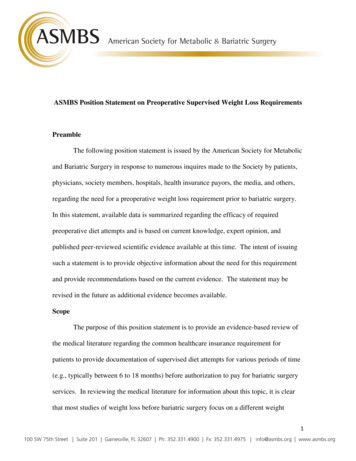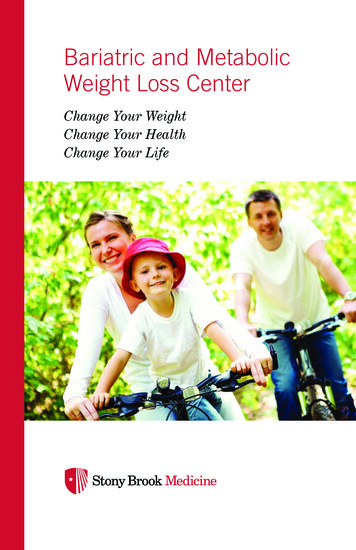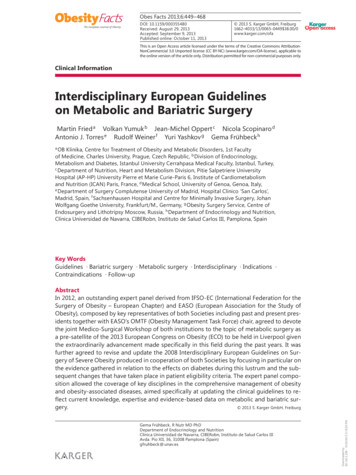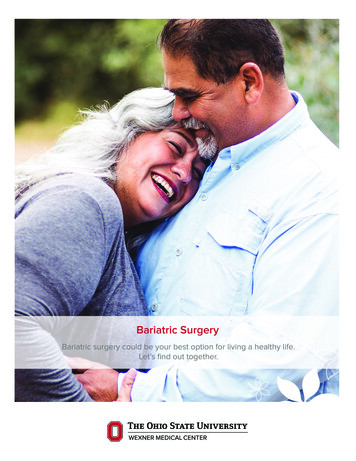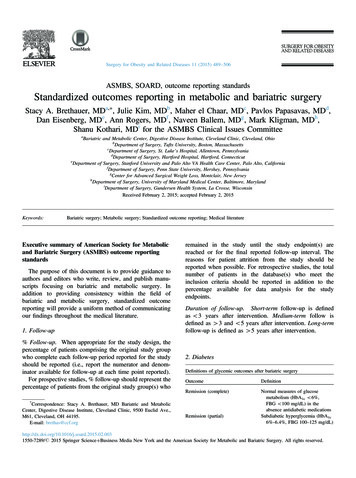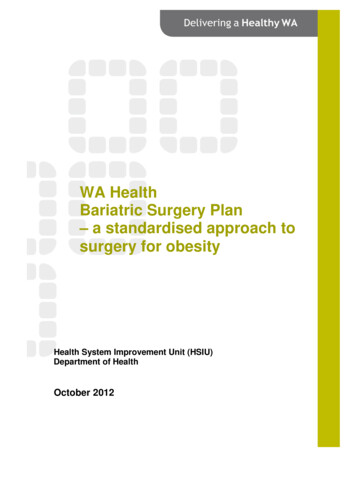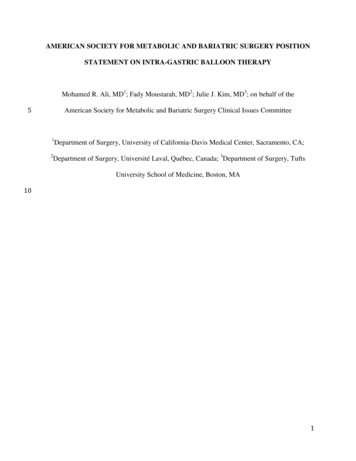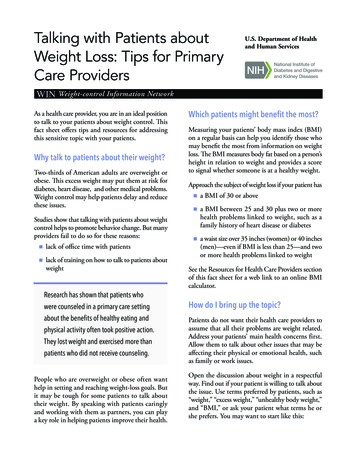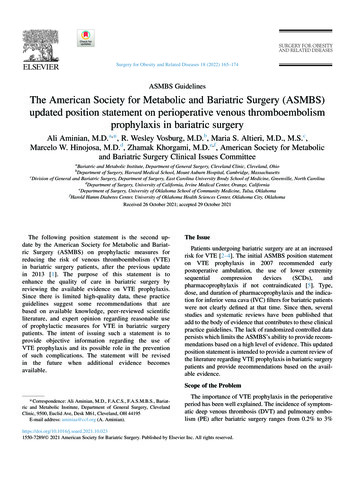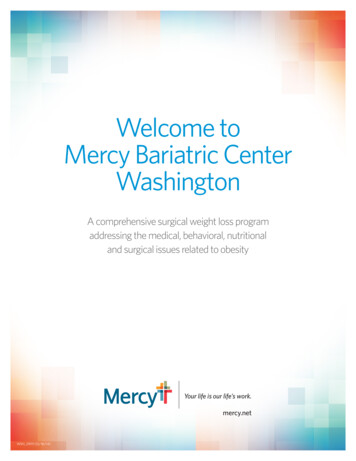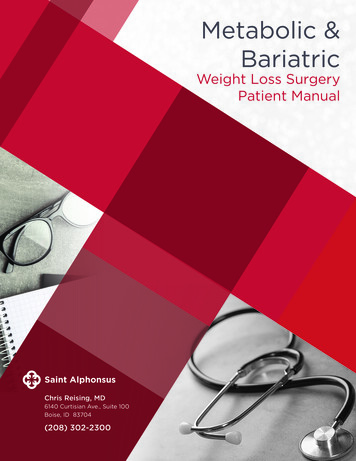
Transcription
Metabolic &BariatricWeight Loss SurgeryPatient ManualSaint AlphonsusChris Reising, MD6140 Curtisian Ave., Suite 100Boise, ID 83704(208) 302-2300
BARIATRIC PATIENT GUIDETABLE OF CONTENTSWelcome Letter. . . . . . . . . . . . . . . . . . . . . . . . . . . . . . . . . . . . . . . . . . . . . . . . . . . . . . . . . . . . . . . . . . . . . . 3The Saint Alphonsus Metabolic and Bariatric Surgery Program Overview. . . . . . . . . . . . . . . . . . 4Meet Our Team . . . . . . . . . . . . . . . . . . . . . . . . . . . . . . . . . . . . . . . . . . . . . . . . . . . . . . . . . . . . . . . . . . . . 4-5The Process . . . . . . . . . . . . . . . . . . . . . . . . . . . . . . . . . . . . . . . . . . . . . . . . . . . . . . . . . . . . . . . . . . . . . . . . . 6Key Contacts . . . . . . . . . . . . . . . . . . . . . . . . . . . . . . . . . . . . . . . . . . . . . . . . . . . . . . . . . . . . . . . . . . . . . . . . 6Who Is A Candidate for Weight Loss Surgery?. . . . . . . . . . . . . . . . . . . . . . . . . . . . . . . . . . . . . . . . . . . 7Benefits of Weight Loss Surgery. . . . . . . . . . . . . . . . . . . . . . . . . . . . . . . . . . . . . . . . . . . . . . . . . . . . . . . 8Types of Weight Loss Surgery Performed. . . . . . . . . . . . . . . . . . . . . . . . . . . . . . . . . . . . . . . . . . . . 8-10Financial and Insurance Considerations. . . . . . . . . . . . . . . . . . . . . . . . . . . . . . . . . . . . . . . . . . . . . . . . 11Get ReadySTOP SMOKING!!. . . . . . . . . . . . . . . . . . . . . . . . . . . . . . . . . . . . . . . . . . . . . . . . . . . . . . . . . . . . . . . . . . . . 12Become a Mindful Eater - Start A Food Journal. . . . . . . . . . . . . . . . . . . . . . . . . . . . . . . . . . . . . . . . . 12Learn the Framework: Basic Bariatric Food Pyramid . . . . . . . . . . . . . . . . . . . . . . . . . . . . . . . . . . . . 13Get Help: Support Options Available for You Before and After Surgery. . . . . . . . . . . . . . . . . . . . 13Get Moving: How to Become More Physically Active . . . . . . . . . . . . . . . . . . . . . . . . . . . . . . . . . 14-16Building Up - A Sample Progressive Walking Program. . . . . . . . . . . . . . . . . . . . . . . . . . . . . . . . . . . 17Preparing for the Emotional & Social Changes. . . . . . . . . . . . . . . . . . . . . . . . . . . . . . . . . . . . . . . 17-18Get SetPre-operative Diet Instruction Overview . . . . . . . . . . . . . . . . . . . . . . . . . . . . . . . . . . . . . . . . . . . . 18-19Foods Allowed Foods to Avoid. . . . . . . . . . . . . . . . . . . . . . . . . . . . . . . . . . . . . . . . . . . . . . . . . . . . . 19Protein Supplement Vendor Options . . . . . . . . . . . . . . . . . . . . . . . . . . . . . . . . . . . . . . . . . . . . . . . 19-20Medication Instructions. . . . . . . . . . . . . . . . . . . . . . . . . . . . . . . . . . . . . . . . . . . . . . . . . . . . . . . . . . . . . . 21Countdown to Surgery Shopping List . . . . . . . . . . . . . . . . . . . . . . . . . . . . . . . . . . . . . . . . . . . . . . . 22Pre-Surgical Instructions. . . . . . . . . . . . . . . . . . . . . . . . . . . . . . . . . . . . . . . . . . . . . . . . . . . . . . . . . . 22-23GoComing to Saint Alphonsus Regional Medical Center in Boise. . . . . . . . . . . . . . . . . . . . . . . . . . . 24Morning of Surgery After Surgery. . . . . . . . . . . . . . . . . . . . . . . . . . . . . . . . . . . . . . . . . . . . . . . . 24-25Going Home (Discharge Instructions). . . . . . . . . . . . . . . . . . . . . . . . . . . . . . . . . . . . . . . . . . . . . . . . . 26Common Post-Surgical Complaints: Pain and Constipation. . . . . . . . . . . . . . . . . . . . . . . . . . . 26-29Additional Troubleshooting Guide. . . . . . . . . . . . . . . . . . . . . . . . . . . . . . . . . . . . . . . . . . . . . . . . . 30-32Vitamin Requirements after Weight Loss Surgery. . . . . . . . . . . . . . . . . . . . . . . . . . . . . . . . . . . . . . 32Medications to Avoid After Gastric Bypass. . . . . . . . . . . . . . . . . . . . . . . . . . . . . . . . . . . . . . . . . . . . 33General Guidelines for Return to Work/Lifting Restrictions. . . . . . . . . . . . . . . . . . . . . . . . . . . . . . 33Post-operative Pathway of Care. . . . . . . . . . . . . . . . . . . . . . . . . . . . . . . . . . . . . . . . . . . . . . . . . . . . . . 34PAGE 2
BARIATRIC PATIENT GUIDEDear Patient,We developed this Weight Loss Surgery Owner‘s Manual to help guide you throughthe entire process of our metabolic and bariatric surgery program. The SaintAlsphonsus Metabolic and Bariatric Surgery Program is a multi-disciplinary andcomprehensive program that is focused on helping you achieve your weight lossand health goals. Dr. Reising performs both gastric bypass and sleeve gastrectomyweight loss surgeries. I perform procedures using either a robotic or laparoscopic,minimally invasive approach, through very small incisions.This Owner‘s Manual covers your pre-operative and post-operative care, along withimportant dietary and lifestyle change recommendations, both before and aftersurgery. Please review this manual at home and bring it with you to the BariatricCenter, hospital and for follow-up visits.We are excited to be a part of your weight loss journey and we look forward toworking with you in partnership for your long-term success.Sincerely,Chris Reising MD, FACSPAGE 3
BARIATRIC PATIENT GUIDEPAGE 4Saint AlphonsusMetabolic and Bariatric Surgery Program OverviewLosing weight is not just about a smaller number on the scale. It is about changing your life and your healthfor the better and becoming the person you want to be. If you have tried endless diets without success andstill need to lose a significant amount of weight, bariatric surgery can be an effective treatment to help youmake a change for health and for life. Our multidisciplinary team is expert at helping you achieve your weightloss and health goals.MEET OUR TEAMDr. Chris Reising graduated from Indiana University Medical School and completedsurgery training at Iowa Methodist Medical Center. He is board-certified by theAmerican Board of Surgery and a fellow of the American College of Surgeons.He specializes in minimally invasive and robotic foregut surgery and endoscopywith an emphasis on metabolic and bariatric surgery. He has over two decades ofbariatric surgery experience and has been a member of the American Society forMetabolic and Bariatric Surgery since 2005. Dr. Reising has five adult children andone pup named Ginger. He is passionate about taking care of surgical patients.When he is not working he loves to cook, kite surf, ski, mountain bike, paint, readbooks and watch movies.Troy DeMasters, PA-C, is a physician assistant certified by the NCCPA andis passionate about caring for surgical patients. He has been practicing as asurgical PA for nearly two decades and specializes in minimally invasive surgeryand robotic surgery.Troy enjoys spending time with his family and participating in his children’ssporting activities. In addition, he enjoys outdoor activities, including boating,skiing and backpacking.Cheyenne Holsclaw, RN, is the lead RN for the bariatrics and general surgery. Sheis responsible for oversight of the department as well as direct patient care.When she is not working Cheyenne enjoys camping, hunting and fishing with herhusband and children.
BARIATRIC PATIENT GUIDEPAGE 5Christy Rosenthal, MA, is a medical assistant with our metabolic and bariatricprogram. She enjoys caring for bariatric patients. In her free time, Christi enjoysspending time with her family and being outdoors.Kyle Kamp RDN, LD, received his undergraduate degree in dietetics from theUniversity of Southern Indiana and completed his post graduate training in nutritionat Idaho State University. He has extensive experience in caring for a bariatricpatient’s nutritional needs. He enjoys hiking, skiing and bow hunting with his wife,friends and family in the mountains of Idaho.Emily Clay RDN, LD was born and raised in Columbus, Ohio. She received herundergraduate and post-graduate training in nutrition at Ohio State University. Shehas extensive experience in bariatric nutrition counseling and immensely enjoysworking with bariatric patients. When she is not working, she enjoys camping,hiking and skiing with her husband and two children.
BARIATRIC PATIENT GUIDEPAGE 6THE PROCESSThe Saint Alphonsus Metabolic and Bariatric Surgery Program is a process that takes six months tocomplete in most cases. Our program and insurance carriers require you to have six (6) monthly medicallysupervised weight loss visits. During this time there may be the need for additional heart and lung testingin order to make sure you are fit enough to undergo a bariatric surgery and are not at risk for heart andlung complications.Additionally, we review your insurance plan to make sure bariatric surgery is a covered benefit. You willmeet Dr. Reising for an initial consultation to start the process and during the course of this 6 month periodyou will need to be evaluated by the physical therapist, dietitian and psychiatrist. Additional dietitian, PTand psychology appointments may be necessary depending on your needs. Our goal is to support youthrough the entire process and help you develop the skills and discipline to ensure your long-term success.Month 1SurgeonconsultMonth 2Month 3Month 4Month 5Month 6Physiciansupervisedweight loss visitPhysiciansupervisedweight loss visitPhysiciansupervisedweight loss visitPhysiciansupervisedweight loss visitPreoperativeConsult sultSupport GroupMeetingSupport GroupMeetingPhysicalTherapy consultKey contacts for scheduling your appointments: General and Scheduling questions; seminars and appointmentsLaurel Duncan. . . . . . . . . . . . . . . . . . . . . . . . . . . . . . . . . . . . . . . . . . . . . . 208-302-2300 Pre-Op Surgery Scheduling Coordinator.Cheyenne Holsclaw . . . . . . . . . . . . . . . . . . . . . . . . . . . . . . . . . . . . . . . . . 208-302-2300 DietitiansKyle Kamp and Emily Clay. . . . . . . . . . . . . . . . . . . . . . . . . . . . . . . . . . . . 208-367-7162
BARIATRIC PATIENT GUIDEPAGE 7WHO IS A CANDIDATEfor Weight Loss Surgery?Candidates for weight loss surgery should meet the following criteria: At least 100 pounds overweight or 100 percent above ideal weight Body Mass Index (BMI) of at least 40, or 35 with severe weight related health problems Severe weight-related health problems such as diabetes, high blood pressure, highcholesterol, heart disease, osteoarthritis, GERD and sleep apnea Non-smokers At least 19 years old A history of obesity and documented attempts of non-surgical weight-loss treatmentsthat have failed. No history of substance abuse No history of uncontrolled or untreated psychiatric or eating disordersA careful review of your medical history and fitness for surgery is important for safety. Not everyone is acandidate for bariatric surgery.Potential patients will need to complete nutritional, fitness and psychological screenings and the reviewconsultation with Dr. Reising before undergoing bariatric surgery. Saint Alphonsus Metabolic and BariatricSurgery Program offers two types of weight loss surgery:1.Sleeve Gastrectomy2. Gastric bypassThese procedures help provide a safe, effective, and sustainable way to lose your excess body weightand improve your health.When you commit to taking the first step to a new life, you will also have a multidisciplinary support teamto back you along the way.If you think you would benefit from weight-loss surgery, talk to us. Find out if you’re a candidate, learnabout risks, benefits, and what to expect by contacting:To schedule your consult today call:Saint Alphonsus Metabolic and Bariatric Surgery Program208-302-2300
BARIATRIC PATIENT GUIDEPAGE 8BENEFITS OF WEIGHT LOSS SURGERYThe impact the weight loss will bring to your overall health should be foremost in your decision to undergosurgery. All weight loss surgeries are considered major surgery and should not be undertaken for cosmeticpurposes.After surgery, most gastric bypass and sleeve gastrectomy patients lose weight rapidly until 12 to 18 months.Patients might lose 30-to-50 percent of their excess weight in the first six months and up to 70 percent oftheir excess weight as early as one year after surgery. Diet and activity level after surgery have an effect onhow much weight is lost and the long-term success of the weight loss.Significant weight loss can improve many obesity related health problems: Type 2 Diabetes: 82 – 98% resolved Hypertension: 69% resolved Depression: 47% reduced Obstructive Sleep Apnea: 74 – 98% resolved GERD (reflux): 72% resolved Quality of Life: 95% improvedEmotional and social changes are often associated with extreme weight loss. Many patients report that theirmood, self-confidence and quality of life improve significantly after surgery.SOURCE: CDC/NCHS, National Health and Nutrition Examination Survey, 2009–2010.TYPES OF SURGERYGASTRIC BYPASSThe Roux-en-Y Gastric Bypass – often called gastric bypass– is considered the “gold standard” of weight loss surgery.There are two components to the procedure. First, a smallstomach pouch, approximately one ounce or 30 millilitersin volume, is created by dividing the top of the stomachfrom the rest of the stomach. Next, the first portion ofthe small intestine is divided, and the bottom end of thedivided small intestine is brought up and connected tothe newly created small stomach pouch. The procedure iscompleted by connecting the top portion of the dividedsmall intestine to the small intestine further down so that the stomach acids and digestive enzymes fromthe bypassed stomach and first portion of small intestine will eventually mix with the food.Gastric bypass works by several mechanisms. First, similar to most bariatric procedures, the newly createdstomach pouch is considerably smaller and facilitates significantly smaller meals, which translates into lesscalories consumed. Additionally, because there is less digestion of food by the smaller stomach pouch,and there is a segment of small intestine that would normally absorb calories as well as nutrients that
BARIATRIC PATIENT GUIDEPAGE 9GASTRIC BYPASS (continued)no longer has food going through it, there is probably to some degree less absorption of calories andnutrients. Most importantly, the rerouting of the food stream produces changes in gut hormones thatpromote satiety, suppress hunger, and reverse one of the primary mechanisms by which obesity inducestype 2 diabetes.Advantages1.Produces significant long-term weight loss (60 to 80 percent excess weight loss)2. Restricts the amount of food that can be consumed3. Produces favorable changes in gut hormones that reduce appetite and enhance satiety4. Typical maintenance of 50% excess weight lossDisadvantages1.It is technically a more complex operation than the gastric sleeve may have slightly highercomplication rates.2. Can lead to long-term vitamin/mineral deficiencies particularly deficits in vitamin B12, iron,calcium, and folate.3. Generally, has a slightly longer recovery than the Sleeve Gastrectomy4. Requires adherence to dietary recommendations, life-long vitamin/mineral supplementation andfollow-up compliance.SLEEVE GASTRECTOMYThe Laparoscopic Sleeve Gastrectomy – often calledthe sleeve – is performed by removing approximately80 percent of the stomach. The remaining stomach is atubular pouch that resembles a banana.This procedure works by several mechanisms. First, thenew stomach pouch holds a considerably smaller volumethan the normal stomach and helps to significantlyreduce the amount of food (and thus calories) that canbe consumed. The greater impact, however, seems to bethe effect the surgery has on gut hormones that impact anumber of factors including hunger, satiety, and blood sugar control.Short term studies show that the sleeve is as effective as the roux-en-Y gastric bypass in terms of weightloss and improvement or remission of diabetes.
BARIATRIC PATIENT GUIDEPAGE 10SLEEVE GASTRECTOMY (continued)There is also evidence that suggest the sleeve, similar to the gastric bypass, is effective in improving type2 diabetes independent of the weight loss. The complication rates of the sleeve fall between those of theadjustable gastric band and the roux-en-y gastric bypass.Advantages1.Restricts the amount of food the stomach can hold2. Induces rapid and significant weight loss that comparative studies find similar to thatof the Roux-en-Y gastric bypass.3. Weight loss of 50% for 3-5 year data, and weight loss comparable to that of the bypasswith maintenance of 50%.4. Does not require re-routing of the food stream like RYGB.5. Involves a relatively short hospital stay of approximately 2 days.6. Causes favorable changes in gut hormones that suppress hunger, reduce appetite andimprove satiety.Disadvantages1.Is a non-reversible procedure.2. Slightly less weight loss and impact on diabetes than gastric bypass.3. Has the potential for long-term vitamin deficiencies particularly Vitamin B12.
BARIATRIC PATIENT GUIDEFINANCIAL AND INSURANCE CONSIDERATIONSWe will assist you in meeting insurance company requirements, but first, call your insurancecompany to find out if bariatric surgery is a covered benefit. If yes, we will next provide them withdocumentation that your surgery is medically necessary due to health issues related to obesity.You may also be asked to provide evidence of your attempts at non-surgical weight loss.Here are some steps to obtaining insurance coverage: Read the “certificate of coverage”that your insurance company isrequired to give you. You might be requiredto obtain a referral fromyour primary care physician. Bring your organized medicalrecords, including your history ofdieting attempts, to the first visitwith Dr. Reising. Document all visits to a health care professional for obesity related issues, and visits youmake to supervised weight loss programs, diet centers and fitness clubs. Keep goodrecords, including receipts. If your surgeon recommends weight loss surgery, we will contact your insurance companyfor pre-authorization.If you have an insurance policy that specifically says it excludes payment for bariatric surgery,there are other options. Many patients choose to pay for the operation themselves. We can helpyou explore payment options.PAGE 11
BARIATRIC PATIENT GUIDEPAGE 12GET READY:STOP SMOKING!!The following is our No Smoking policy for the Bariatric Surgery Program:All our patients are required to be tobacco free for a minimum of 6 months prior to surgery. It iscompletely contradictory to pursue weight loss surgery for health benefits and continue to smoke whichis an even larger health risk for heart attack, stroke and cancer than is obesity. Additionally, smokingincreases the risk of early and long-term complications related to bariatric surgery. Early complicationsthat are increased by smoking include wound infections, pneumonia, and leaks from the staple lines andconnections made at the time of surgery. Late complications related to smoking include marginal ulcerswhich can bleed or perforate.If you commit to quitting smoking you will need to communicate the date that you quit to your primarycare doctor, the program coordinator and Dr. Reising. We will need to perform nicotine tests monthlyfor 6 months to ensure you have succeeded. The byproducts of nicotine remain in your system for 30days. If you fail the nicotine testing you will not be allowed to participate in the metabolic and bariatricsurgery program until you have successfully quit.BECOME A MINDFUL EATER START FOOD JOURNALINGIt is critical to your weight loss success that you learn to become a “mindful eater”.This means several things:1.Taking time to prepare healthy meals.2. Making good food choices, avoidingempty calories and processed foods.3. Eating in a non-distracted environment(not in front of the television).410 Calories4. Listening to your body’s response tofood (stopping when you are no longerhungry but not full).5. Food Journaling means writing downeverything you put in your mouth anddocumenting the calories and protein grams in the foods you eat.6. Reviewing your food journal and daily calories and protein gram each night and each week.As you learn more about a healthy diet and your bodies metabolic needs from applying these very basicskills you will start to feel better about yourself and how you are taking care of your body. These skillswill become good habits to replace old bad habits.It is important to know that much of the success of maintaining your weight loss in the years following asuccessful weight loss surgery are attributable to the 6 skills described above.
BARIATRIC PATIENT GUIDEPAGE 13LEARN THE FRAMEWORK:Basic Bariatric Food PyramidAfter weight loss surgery, your ideal food pyramid, and the order of foods you eat, should change.The majority of your nutrition, or at least 1/2 of each meal, should now come from high protein foods,and protein should always be eaten first. This will maximize nutritional quality for volume; as well asmaximize and extend fullness on limited volume. That translates to less sense of deprivation and fewercravings/triggers for unhealthy food choices. There are many resources to learn more about protein,carbohydrates, and fats; you will see more references and information throughout this Manual.Vegetables and fruits should be eaten after protein; making up about 1/3 of each meal. Carbohydratesshould be eaten last; about 1/6 of your total meal. Choose fruit and complex carbohydrates high in fiber.Avoid simple carbs food such as sweets, cakes, cookies, chips, crackers and other non-nutritious snackfoods. Also remember that bread, pasta and rice swell and expand in your new stomach. Sugars shouldalso be limited; try sugar free products, artificial sweeteners, and sugar-free water flavorings such asCrystal Light.Healthy fats are fine but are more dense in calories. When cooking, substitute healthy heart fats suchas these oils: olive, sunflower, and canola instead of regular butter. Experiment with alternative cookingmethods such as grilling, steaming, broiling, roasting, and baking rather than frying, to further decreasefat. Take the skin off chicken before cooking.Although fluid intake is not in this pyramid, we recommend 64 fluid oz per day; preferably water-based, sugarfree and non-carbonated. We strongly recommend that you limit caffeine and carbonation for the rest ofyour life. Caffeine can stimulate appetite or cravings/triggers for simple carbohydrates; caffeine is also a nonselective stimulant, meaning it increases your appetite. It is also a diuretic, which increases urination.GET HELP: SUPPORT & RESOURCESAvailable For You Before And After SurgeryDietitian ServicesOur Dietitians see our patients both pre- and post-operatively, and are also available outside of regularlyscheduled visits, and accessible by email and telephone. They also participate in our support groups.Support GroupWe offer regular, live Bariatric support groups, available to both pre- and post-op weight loss surgerypatients. Each meeting lasts about an hour and meetings are held at various locations throughout theregion. We announce each meeting via our e-announcement, and post regular group meeting dates/times on the Website Event Calendar and at the Bariatric Center reception desk.Group meetings are led by various program staff, and focus on those behaviors proven to bestimpact successful weight loss and long-term weight loss maintenance. We include hot topics, cookingdemonstrations, and periodic walking outings for fun and learning. We will have frequent guest speakerson topics of interest to our patients, and we welcome your input.Why should you attend? It can be challenging to lose and maintain without the support of others in yourshoes. We know that Support Group attendance is tied closely to greater weight loss success and long-termmaintenance. And there is NO CHARGE—this is a free lifetime benefit to our Saint Alphonsus patients!
BARIATRIC PATIENT GUIDEPAGE 14Behavioral PsychologyOur behavioral psychologists are a great resource for you to utilize to help you achieve your weightloss goals. They can evaluate your current lifestyle and patterns of behavior as it relates to eating andexercise and help you develop alternative strategies to use in your day to day life that will help youchange bad habits into good habits.GET MOVING:How To Become More Physically ActiveYou can find good ideas on becoming more physically active on websites like: http://win.niddk.nih.gov/publications/active.htm activity-for-obese-people www.fitness.gov/fitness.htm www.nhlbi.nih.gov/health/public/heart/obesity/lose wt/phy act.htm http://www.sparkpeople.comThere is good information on the Internet, but start with reputable sources, and check out informationand advice with your primary care doctor or Dr. Reising before you follow it.The DO’s and DON’TSof Starting a Physical Activity Program Do –see your doctor before starting an exerciseprogram to get his/her medical approval, andany activity/target heart rate restrictions. Do – drink plenty of water. You will need toincrease your fluid intake as you exercise. Do - find a good place for exercise. For example,malls are a great choice for walking in allseasons, as they have an even surface and thetemperature is consistent. Also, many malls openbefore the stores do just so people can walk andexercise. Don’t – Don‘t exercise immediately before orafter a meal. Don’t – Avoid engaging in outdoor activityduring severe weather or ice, or if poor light orunsafe/unfamiliar surroundings.
BARIATRIC PATIENT GUIDEPAGE 15What if Walking Hurts too Much?Consider these options:1.Water aerobics/fitness classes; water is gentle on thejoints, but provides resistance (and thus increasesmuscle strength and toning), and is cardiovascular.2. Recumbent or exercise bike; just be sure the angleof the knee bend is less than 90 degrees at maximum.3. Low-impact or elliptical equipment, either purchased orat a facility. Before purchasing, learn proper use andfunction of the equipment, both for safety and to see ifyou like it. To get motivated to use a piece of exerciseequipment, consider exercising with a buddy or a group/class.4. Consider your view. You might want to set up equipment in front of a TV, or listen to music.Setting Your Goals/Creating an Environment for Success1.First, determine your starting point: have youexercised previously, and if so, to what extent?If you are starting from relative inactivity; setreasonable, doable goals, and increase timeand/or level of intensity gradually.2.Consider carefully your choice(s) for physicalactivity, and any joint/mobility or healthlimitations.3.Consider equipment options and availablefacilities in your area, and any specialaccommodations needed. If you are notfamiliar with these options, ask your chosenfacility to help familiarize you with what theyhave to offer, and demonstrate proper use ofequipment.4. Think also about equipment needed indifferent environments; for example, tennisshoes kept at work for quick walks whenopportunities present, towels, water bottles,deodorant, etc.5.Ensure you have the proper equipment to suityour exercise goals. For example, make surethat you have good, sturdy walking shoes thatfit properly.6. You may want to consider temporarily usingthe services of a personal trainer, until yourroutine is well-established; they not only canhelp you get started on a program but canshow you some simple things to do that willprevent injury. The best way to prevent injury isto by stretching properly – especially after youexercise.7.Consider also what time of day works bestto ensure consistency; many people find thatmorning works best, so they are not so tiredor struggle with competing obligations later inthe day.8. Most patients will need to consider severaloptions, with backup plans; try to work withyour family to accommodate everyone‘s needswith reasonable compromise, mindful of theimportant role physical activity plays in yourlong-term success.Before You StartAs above, talk to your surgeon, as well as yourprimary care doctor or your cardiologist. Learn howto take your own pulse so that you can monitoryour heart rate. Your doctor may give some targetgoals for you. Check your pulse often duringexercise to ensure you stay within the target heartrange; as you become more conditioned (fitter andhealthier!), you will note that your pulse rate willdecrease during strenuous activity.
BARIATRIC PATIENT GUIDEPAGE 16Your Target Heart RateGenerally, your maximum heart rate should not exceed220 minus your age in years. If you are 40 years old,your maximum heart rate should be 180 beats perminutes. At peak effort, your heart rate should ideallyreach about 60 – 80 percent of the maximum, but youwill likely need to gradually build to this intensity level.(For example, if you are 40 years old, then your peakheart rate would be 110 to 140 beats per minute.) Youshould review this with your doctor because somepeople will have different goals, and some medicationsaffect the heart rate (such as beta blockers likemetoprolol); you can also review with a personaltrainer.Check Your Pulse And Target Heart Rate:At least half way through your activity or walk, check your pulse. If you have not reached your target, youcan increase intensity or pick up the pace. Check your pulse again when you have completed the activity(you might want to check it more often; again, consult with your doctor). Within ten minutes after youhave finished, your heart rate should have decreased and you should be able to catch your breath.You Should Be Concerned if You Notice: Chest pain after or during exercise. Thi
Chris Reising, MD 6140 Curtisian Ave., Suite 100 Boise, ID 83704 (208) 302-2300 Saint Alphonsus Metabolic & Bariatric Weight Loss Surgery Patient Manual

